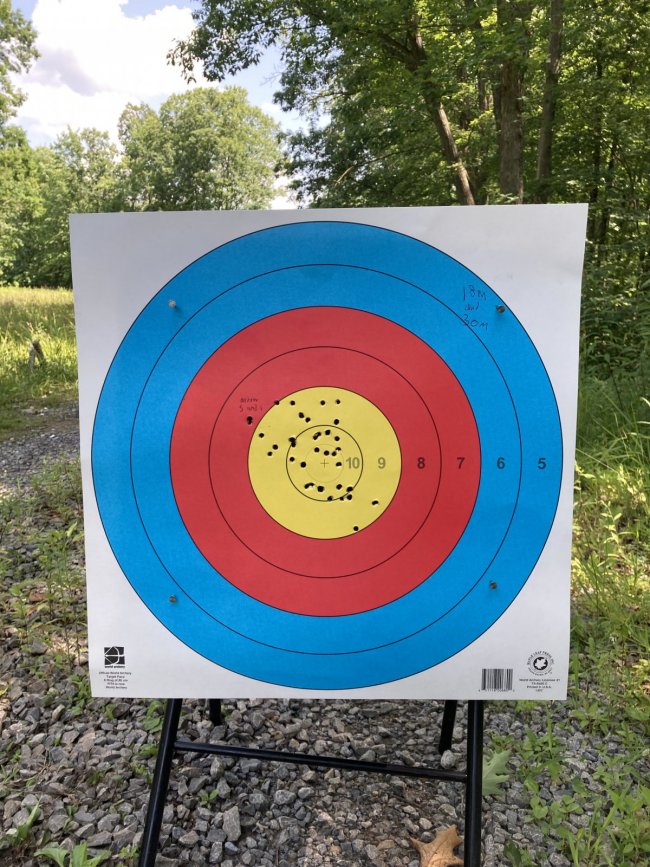So…we have what I believe to be a arrow configuration that will meet her needs.
Life started with 6 shafts being squared. Then we added nocks and spine aligned them. 3 of the 6 were fletched with the slight left lean we always use with “purpleshia” (yes, her bow has a name).
We started at 18m and bare vs fletched was far apart (with the bare group to the left). 1” was removed and the groups individually got very small; distance between groups was also smaller. We whacked another 3/4” and we had convergence.
Next we checked the paper tune as just a reference and the results were as expected.
Time for 30m!
The group sizes and distances were what we expected, so we moved right to 50m for final.
(Ie we were sure the groups would be at least on the butt!)
Based upon group 1, we whacked another 1”. At this point my archer was getting tired, hot, annoyed by bugs and generally irritable, her form was not what it typically is, but we still needed to test.
Group 2 at 50m showed convergence, perhaps a bit past (all bare shafts were slightly right of the fletched, but just barely so).
At this point we called it good and dropped back to 30m for a sanity check; bare shafts still to the left at 30”, but close to convergence.
So we now have our candidate configuration and I will fletch the remaining 3 arrows.
Beyond this point the only way to see what happens is for her to fly 2-3 groups of 6 ends and to score them.
I’m hoping we can do this tomorrow so we can put a stake in the ground and call it good.
I was really surprised at the effect tuning the shaft length had on the individual groups of the fletched and bare shaft arrows.
I can’t wait to see what happens numerically when she scores with these!
Prior configuration:
Victory VAP V1
700 spine
26 5/8” shaft
120gr point (started life as 140gr, cut down as required)
Bohning F-nock
New configuration:
Victory VAP V1
600 spine
28 1/4” shaft
100gr point
Bohning F-nock
I’m debating if I need to be a 1/4 longer, hence why I’ll wait till sights in and scores.
8 days till we leave for Ohio!
I wanted to thank all of you for the input and especially outrider.
The kitchen table style discussion we had here really helps with the debugging process
Life started with 6 shafts being squared. Then we added nocks and spine aligned them. 3 of the 6 were fletched with the slight left lean we always use with “purpleshia” (yes, her bow has a name).
We started at 18m and bare vs fletched was far apart (with the bare group to the left). 1” was removed and the groups individually got very small; distance between groups was also smaller. We whacked another 3/4” and we had convergence.
Next we checked the paper tune as just a reference and the results were as expected.
Time for 30m!
The group sizes and distances were what we expected, so we moved right to 50m for final.
(Ie we were sure the groups would be at least on the butt!)
Based upon group 1, we whacked another 1”. At this point my archer was getting tired, hot, annoyed by bugs and generally irritable, her form was not what it typically is, but we still needed to test.
Group 2 at 50m showed convergence, perhaps a bit past (all bare shafts were slightly right of the fletched, but just barely so).
At this point we called it good and dropped back to 30m for a sanity check; bare shafts still to the left at 30”, but close to convergence.
So we now have our candidate configuration and I will fletch the remaining 3 arrows.
Beyond this point the only way to see what happens is for her to fly 2-3 groups of 6 ends and to score them.
I’m hoping we can do this tomorrow so we can put a stake in the ground and call it good.
I was really surprised at the effect tuning the shaft length had on the individual groups of the fletched and bare shaft arrows.
I can’t wait to see what happens numerically when she scores with these!
Prior configuration:
Victory VAP V1
700 spine
26 5/8” shaft
120gr point (started life as 140gr, cut down as required)
Bohning F-nock
New configuration:
Victory VAP V1
600 spine
28 1/4” shaft
100gr point
Bohning F-nock
I’m debating if I need to be a 1/4 longer, hence why I’ll wait till sights in and scores.
8 days till we leave for Ohio!
I wanted to thank all of you for the input and especially outrider.
The kitchen table style discussion we had here really helps with the debugging process

Last edited:



 (easy to do with one of
(easy to do with one of 
